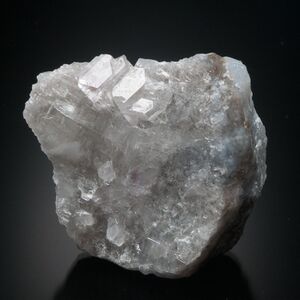Anhydrite
Anhydrite is the form of gypsum without the water particles present. This means that it turns into gypsum when it comes in contact with water. Its chemical formula is CaSO4. Anhydrite originates form a sea or saline lake and forms when this water body evaporates. It can be found in the subsurface interbedded with rocks that include halite, gypsum and limestone. Hydrothermal deposits also contain anhydrite as a vein-filling material.
Characteristics
Halite is colorless, white and light shades of brown, red, grey, pink, blue and violet can be present. Its streak is white and halite has a vitreous to pearly luster. Its hardness is medium hard, a 3 to 3.5 on Mohr's scale. It can be recognized by its perfect cubic cleavage, hardness in contrary to gypsum, higher specific gravity than calcite and it has no acid reaction.
References
- Bonewitz, Ronald Louis (2012). Rocks and Minerals. DK Publishing. p. 110. ISBN 978-0-7566-9042-7.
Anhydrite

| Type | Salt stone |
|---|---|
| Chemical formula | CaSO4 |
| Color | colorless with shades of color |
| Streak | White |
| Luster | Vitreous to pearly |
| Hardness | Medium |
| Cleavage | Cubic |
| Image | Anhydrite |